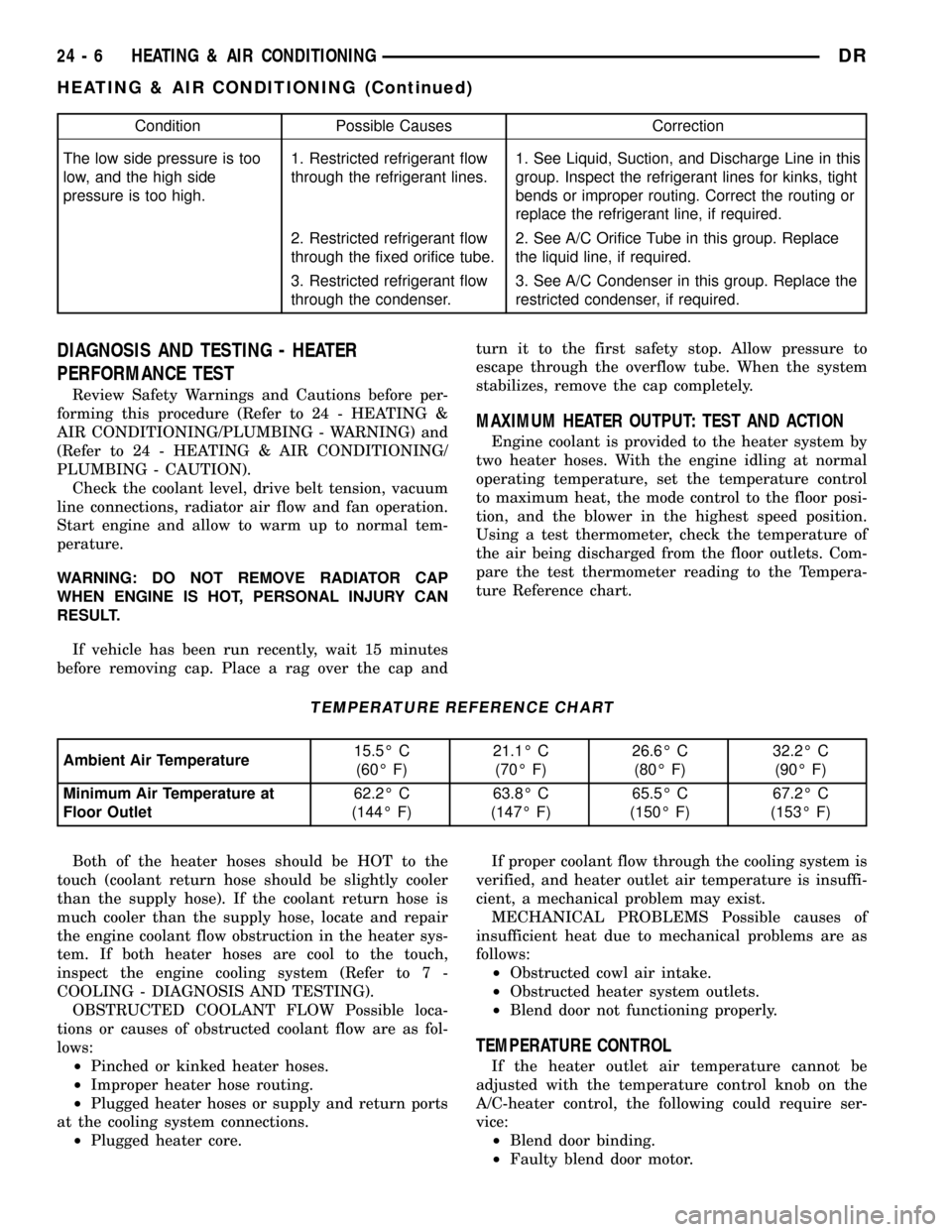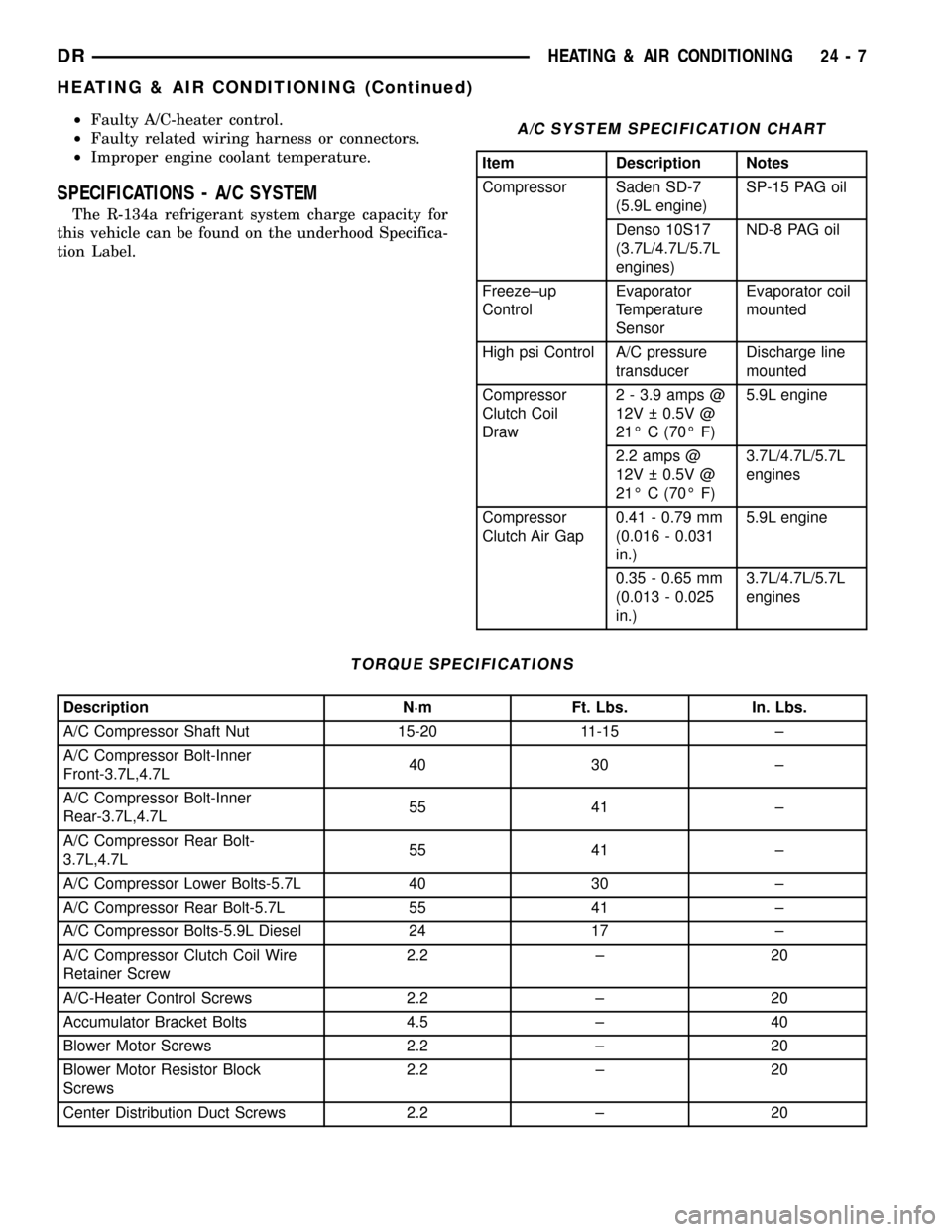1998 DODGE RAM 1500 engine coolant
[x] Cancel search: engine coolantPage 2488 of 2627

HEATING & AIR CONDITIONING
TABLE OF CONTENTS
page page
HEATING & AIR CONDITIONING
DESCRIPTION
DESCRIPTION - ENGINE COOLING
SYSTEM REQUIREMENTS...............1
DESCRIPTION - HEATER AND AIR
CONDITIONER........................1
OPERATION - HEATER AND AIR
CONDITIONER........................1
DIAGNOSIS AND TESTING
DIAGNOSIS AND TESTING - A/C
PERFORMANCE.......................3DIAGNOSIS AND TESTING - HEATER
PERFORMANCE TEST..................6
SPECIFICATIONS - A/C SYSTEM............7
CONTROLS.............................9
DISTRIBUTION..........................26
PLUMBING.............................41
HEATING & AIR
CONDITIONING
DESCRIPTION
DESCRIPTION - ENGINE COOLING SYSTEM
REQUIREMENTS
To maintain the performance level of the heating,
ventilation and air conditioning (HVAC) system, the
engine cooling system must be properly maintained.
The use of a bug screen is not recommended. Any
obstructions in front of the radiator or A/C condenser
will reduce the performance of the A/C and engine
cooling systems.
The engine cooling system includes the radiator,
thermostat, radiator hoses and the engine coolant
pump. Refer to Cooling for more information before
opening or attempting any service to the engine cool-
ing system.
DESCRIPTION - HEATER AND AIR
CONDITIONER
A manually controlled single zone type heating-air
conditioning system or a manually controlled dual
zone type heating-air conditioning system is available
on this model.
All vehicles are equipped with a common heater,
ventilation and air conditioning (HVAC) housing (Fig.
1). The system combines air conditioning, heating,
and ventilating capabilities in a single unit housing
mounted within the passenger compartment under
the instrument panel. The HVAC housing includes:
²Blower motor
²Blower motor resistor block²Heater core
²Evaporator coil
²Blend door and actuator
²Defrost door and actuator
²Mode door and actuator
²Recirculation door and actuator
Based upon the system and mode selected, condi-
tioned air can exit the HVAC housing through one or
a combination of the three main housing outlets:
defrost, panel or floor. The defrost outlet is located on
the top of the housing, the panel outlet is located on
the face of the housing and the floor outlet is located
on the bottom of the housing. Once the conditioned
air exits the unit housing, it is further directed
through molded plastic ducts to the various outlets in
the vehicle interior. These outlets and their locations
are as follows:
²Defroster Outlet- A single large defroster out-
let is located in the center of the instrument panel
top cover, near the base of the windshield.
²Side Window Demister Outlets- There are
two side window demister outlets, one is located at
each outboard end of the instrument panel top cover,
near the belt line at the A-pillars.
²Panel Outlets- There are four panel outlets in
the instrument panel, one located near each outboard
end of the instrument panel facing the rear of the
vehicle and two located near the top of the instru-
ment panel center bezel.
²Front Floor Outlets- There are two front floor
outlets, one located above each side of the floor panel
center tunnel near the dash panel.
OPERATION - HEATER AND AIR CONDITIONER
The heating and air conditioning systems pulls
outside (ambient) air through the cowl opening at the
base of the windshield, then into the plenum cham-
DRHEATING & AIR CONDITIONING 24 - 1
Page 2493 of 2627

Condition Possible Causes Correction
The low side pressure is too
low, and the high side
pressure is too high.1. Restricted refrigerant flow
through the refrigerant lines.1. See Liquid, Suction, and Discharge Line in this
group. Inspect the refrigerant lines for kinks, tight
bends or improper routing. Correct the routing or
replace the refrigerant line, if required.
2. Restricted refrigerant flow
through the fixed orifice tube.2. See A/C Orifice Tube in this group. Replace
the liquid line, if required.
3. Restricted refrigerant flow
through the condenser.3. See A/C Condenser in this group. Replace the
restricted condenser, if required.
DIAGNOSIS AND TESTING - HEATER
PERFORMANCE TEST
Review Safety Warnings and Cautions before per-
forming this procedure (Refer to 24 - HEATING &
AIR CONDITIONING/PLUMBING - WARNING) and
(Refer to 24 - HEATING & AIR CONDITIONING/
PLUMBING - CAUTION).
Check the coolant level, drive belt tension, vacuum
line connections, radiator air flow and fan operation.
Start engine and allow to warm up to normal tem-
perature.
WARNING: DO NOT REMOVE RADIATOR CAP
WHEN ENGINE IS HOT, PERSONAL INJURY CAN
RESULT.
If vehicle has been run recently, wait 15 minutes
before removing cap. Place a rag over the cap andturn it to the first safety stop. Allow pressure to
escape through the overflow tube. When the system
stabilizes, remove the cap completely.
MAXIMUM HEATER OUTPUT: TEST AND ACTION
Engine coolant is provided to the heater system by
two heater hoses. With the engine idling at normal
operating temperature, set the temperature control
to maximum heat, the mode control to the floor posi-
tion, and the blower in the highest speed position.
Using a test thermometer, check the temperature of
the air being discharged from the floor outlets. Com-
pare the test thermometer reading to the Tempera-
ture Reference chart.
TEMPERATURE REFERENCE CHART
Ambient Air Temperature15.5É C
(60É F)21.1É C
(70É F)26.6É C
(80É F)32.2É C
(90É F)
Minimum Air Temperature at
Floor Outlet62.2É C
(144É F)63.8É C
(147É F)65.5É C
(150É F)67.2É C
(153É F)
Both of the heater hoses should be HOT to the
touch (coolant return hose should be slightly cooler
than the supply hose). If the coolant return hose is
much cooler than the supply hose, locate and repair
the engine coolant flow obstruction in the heater sys-
tem. If both heater hoses are cool to the touch,
inspect the engine cooling system (Refer to 7 -
COOLING - DIAGNOSIS AND TESTING).
OBSTRUCTED COOLANT FLOW Possible loca-
tions or causes of obstructed coolant flow are as fol-
lows:
²Pinched or kinked heater hoses.
²Improper heater hose routing.
²Plugged heater hoses or supply and return ports
at the cooling system connections.
²Plugged heater core.If proper coolant flow through the cooling system is
verified, and heater outlet air temperature is insuffi-
cient, a mechanical problem may exist.
MECHANICAL PROBLEMS Possible causes of
insufficient heat due to mechanical problems are as
follows:
²Obstructed cowl air intake.
²Obstructed heater system outlets.
²Blend door not functioning properly.
TEMPERATURE CONTROL
If the heater outlet air temperature cannot be
adjusted with the temperature control knob on the
A/C-heater control, the following could require ser-
vice:
²Blend door binding.
²Faulty blend door motor.
24 - 6 HEATING & AIR CONDITIONINGDR
HEATING & AIR CONDITIONING (Continued)
Page 2494 of 2627

²Faulty A/C-heater control.
²Faulty related wiring harness or connectors.
²Improper engine coolant temperature.
SPECIFICATIONS - A/C SYSTEM
The R-134a refrigerant system charge capacity for
this vehicle can be found on the underhood Specifica-
tion Label.
A/C SYSTEM SPECIFICATION CHART
Item Description Notes
Compressor Saden SD-7
(5.9L engine)SP-15 PAG oil
Denso 10S17
(3.7L/4.7L/5.7L
engines)ND-8 PAG oil
Freeze±up
ControlEvaporator
Temperature
SensorEvaporator coil
mounted
High psi Control A/C pressure
transducerDischarge line
mounted
Compressor
Clutch Coil
Draw2 - 3.9 amps @
12V 0.5V @
21É C (70É F)5.9L engine
2.2 amps @
12V 0.5V @
21É C (70É F)3.7L/4.7L/5.7L
engines
Compressor
Clutch Air Gap0.41 - 0.79 mm
(0.016 - 0.031
in.)5.9L engine
0.35 - 0.65 mm
(0.013 - 0.025
in.)3.7L/4.7L/5.7L
engines
TORQUE SPECIFICATIONS
Description N´m Ft. Lbs. In. Lbs.
A/C Compressor Shaft Nut 15-20 11-15 ±
A/C Compressor Bolt-Inner
Front-3.7L,4.7L40 30 ±
A/C Compressor Bolt-Inner
Rear-3.7L,4.7L55 41 ±
A/C Compressor Rear Bolt-
3.7L,4.7L55 41 ±
A/C Compressor Lower Bolts-5.7L 40 30 ±
A/C Compressor Rear Bolt-5.7L 55 41 ±
A/C Compressor Bolts-5.9L Diesel 24 17 ±
A/C Compressor Clutch Coil Wire
Retainer Screw2.2 ± 20
A/C-Heater Control Screws 2.2 ± 20
Accumulator Bracket Bolts 4.5 ± 40
Blower Motor Screws 2.2 ± 20
Blower Motor Resistor Block
Screws2.2 ± 20
Center Distribution Duct Screws 2.2 ± 20
DRHEATING & AIR CONDITIONING 24 - 7
HEATING & AIR CONDITIONING (Continued)
Page 2521 of 2627

INSTALLATION
(1) Install the floor distribution duct onto the bot-
tom of the HVAC housing.
(2) Install the five screws that secure the floor dis-
tribution duct to the HVAC housing. Tighten the
screws to 2.2 N´m (20 in. lbs.).
(3) Install the HVAC housing (Refer to 24 - HEAT-
ING & AIR CONDITIONING/DISTRIBUTION/HVAC
HOUSING - INSTALLATION).
HVAC HOUSING
REMOVAL
WARNING: ON VEHICLES EQUIPPED WITH AIR-
BAGS, DISABLE THE AIRBAG SYSTEM BEFORE
ATTEMPTING ANY STEERING WHEEL, STEERING
COLUMN, OR INSTRUMENT PANEL COMPONENT
DIAGNOSIS OR SERVICE. DISCONNECT AND ISO-
LATE THE BATTERY NEGATIVE (GROUND) CABLE,
THEN WAIT TWO MINUTES FOR THE AIRBAG SYS-
TEM CAPACITOR TO DISCHARGE BEFORE PER-
FORMING FURTHER DIAGNOSIS OR SERVICE. THIS
IS THE ONLY SURE WAY TO DISABLE THE AIRBAG
SYSTEM. FAILURE TO TAKE THE PROPER PRE-
CAUTIONS COULD RESULT IN AN ACCIDENTAL
AIRBAG DEPLOYMENT AND POSSIBLE PERSONAL
INJURY.
NOTE: The HVAC housing must be removed from
the vehicle and the two halves of the housing sep-
arated for service access of the heater core, evap-
orator coil, defrost door, blend door(s) and the
recirculation door.
(1) Disconnect and isolate the battery negative
cable.
(2) Drain the engine cooling system (Refer to 7 -
COOLING - STANDARD PROCEDURE).
(3) Recover the refrigerant from the refrigerant
system (Refer to 24 - HEATING & AIR CONDITION-
ING/PLUMBING - STANDARD PROCEDURE -
REFRIGERANT RECOVERY).
(4) Disconnect the liquid refrigerant line fitting
from the evaporator inlet tube (Refer to 24 - HEAT-
ING & AIR CONDITIONING/PLUMBING/REFRIG-
ERANT LINE COUPLER - REMOVAL). Discard the
O-ring seal and install plugs in, or tape over the
opened liquid refrigerant line fitting and evaporator
inlet tube.
(5) Remove the accumulator (Refer to 24 - HEAT-
ING & AIR CONDITIONING/PLUMBING/ACCU-
MULATOR - REMOVAL). Discard the O-ring seals
and install plugs in, or tape over the opened refrig-
erant line fittings and evaporator outlet tube.(6) Disconnect the heater hoses from the heater
core tubes. Install plugs in, or tape over the opened
heater core tubes.
(7) Remove the powertrain control module (PCM)
from the engine compartment to gain access to the
HVAC housing retaining nuts (Refer to 8 - ELECTRI-
CAL/ELECTRONIC CONTROL MODULES/POWER-
TRAIN CONTROL MODULE - REMOVAL).
(8) Remove the two nuts from the HVAC housing
mounting studs in the engine compartment.
(9) Remove the instrument panel from the vehicle
(Refer to 23 - BODY/INSTRUMENT PANEL -
REMOVAL).
(10) Remove the bolt that secures the HVAC hous-
ing to the floor bracket located in the center of the
vehicle (Fig. 9).
(11) Remove the two nuts from the HVAC housing
mounting studs in the passenger compartment.
(12) Remove the HVAC housing from inside the
vehicle. Take care not to allow any remaining coolant
to drain onto the vehicles interior.
Fig. 9 HVAC Housing - Dual Zone Shown, Single
Zone Typical
1 - NUT
2 - PASSENGER BLEND DOOR ACTUATOR
3 - NUT
4 - INLET BAFFLE
5 - RECIRCULATION DOOR ACTUATOR
6 - RECIRCULATION DOOR
7 - DRIVER SIDE BLEND DOOR ACTUATOR
8 - HVAC HOUSING
9 - BOLT
10 - DEFROSTER DOOR ACTUATOR
11 - MODE DOOR ACTUATOR
24 - 34 DISTRIBUTIONDR
FLOOR DISTRIBUTION DUCT (Continued)
Page 2529 of 2627

REFRIGERANT OIL
DESCRIPTION.........................68
OPERATION...........................69
STANDARD PROCEDURE - REFRIGERANT
OIL LEVEL...........................69
SERVICE PORT VALVE CORE
DESCRIPTION.........................70
REMOVAL - SERVICE PORT VALVE CORES . . 70
INSTALLATION.........................70
SUCTION LINE
DESCRIPTION.........................70REMOVAL
REMOVAL - 5.9L DIESEL ENGINE.........70
REMOVAL - 3.7L/4.7L AND 5.7L HEMI
ENGINE.............................71
INSTALLATION
INSTALLATION - 5.9L DIESEL ENGINE.....72
INSTALLATION - 3.7L/4.7L AND 5.7L HEMI
ENGINE.............................73
PLUMBING
DESCRIPTION - REFRIGERANT LINE
The refrigerant lines and hoses are used to carry
the refrigerant between the various air conditioning
system components. A barrier hose design with a
nylon tube, which is sandwiched between rubber lay-
ers, is used for the R-134a air conditioning system on
this vehicle. This nylon tube helps to further contain
the R-134a refrigerant, which has a smaller molecu-
lar structure than R-12 refrigerant. The ends of the
refrigerant hoses are made from lightweight alumi-
num or steel, and commonly use braze-less fittings.
Any kinks or sharp bends in the refrigerant plumb-
ing will reduce the capacity of the entire air condi-
tioning system. Kinks and sharp bends reduce the
flow of refrigerant in the system. A good rule for the
flexible hose refrigerant lines is to keep the radius of
all bends at least ten times the diameter of the hose.
In addition, the flexible hose refrigerant lines should
be routed so they are at least 80 millimeters (3
inches) from an exhaust manifold.
OPERATION- REFRIGERANT LINES
High pressures are produced in the refrigerant sys-
tem when the air conditioning compressor is operat-
ing. Extreme care must be exercised to make sure
that each of the refrigerant system connections is
pressure-tight and leak free. It is a good practice to
inspect all flexible hose refrigerant lines at least once
a year to make sure they are in good condition and
properly routed.
The refrigerant lines and hoses are coupled with
other components of the HVAC system with either
O-rings or dual plane seals.
The refrigerant lines and hoses cannot be repaired
and, if faulty or damaged, they must be replaced.
WARNING
ENGINE COOLING SYSTEM
WARNING: THE ENGINE COOLING SYSTEM IS
DESIGNED TO DEVELOP INTERNAL PRESSURES
OF 97 TO 123 KILOPASCALS (14 TO 18 POUNDS
PER SQUARE INCH). DO NOT REMOVE OR
LOOSEN THE COOLANT PRESSURE CAP, CYLIN-
DER BLOCK DRAIN PLUGS, RADIATOR DRAIN,
RADIATOR HOSES, HEATER HOSES, OR HOSE
CLAMPS WHILE THE ENGINE COOLING SYSTEM IS
HOT AND UNDER PRESSURE. FAILURE TO
OBSERVE THIS WARNING CAN RESULT IN SERI-
OUS BURNS FROM THE HEATED ENGINE COOL-
ANT. ALLOW THE VEHICLE TO COOL FOR A
MINIMUM OF 15 MINUTES BEFORE OPENING THE
COOLING SYSTEM FOR SERVICE.
24 - 42 PLUMBINGDR
Page 2550 of 2627

(12) Reconnect the battery negative cable.
(13) Evacuate the refrigerant system (Refer to 24 -
HEATING & AIR CONDITIONING/PLUMBING -
STANDARD PROCEDURE - REFRIGERANT SYS-
TEM EVACUATE).
(14) Charge the refrigerant system (Refer to 24 -
HEATING & AIR CONDITIONING/PLUMBING -
STANDARD PROCEDURE - REFRIGERANT SYS-
TEM CHARGE).
HEATER CORE
DESCRIPTION
The heater core is located in the HVAC housing,
behind the instrument panel. It is a heat exchanger
made of rows of tubes and fins.
OPERATION
Engine coolant is circulated through the heater
hoses to the heater core at all times. As the coolant
flows through the heater core, heat is removed from
the engine and is transferred to the heater core fins
and tubes. Air directed through the heater core picks
up the heat from the heater core fins. The blend door
allows control of the heater output air temperature
by regulating the amount of air flowing through the
heater core within the HVAC housing. The blower
motor speed controls the volume of air flowing
through the HVAC housing.
The heater core cannot be repaired and, if faulty or
damaged, it must be replaced.
REMOVAL
WARNING: ON VEHICLES EQUIPPED WITH AIR-
BAGS, DISABLE THE AIRBAG SYSTEM BEFORE
ATTEMPTING ANY STEERING WHEEL, STEERING
COLUMN, OR INSTRUMENT PANEL COMPONENT
DIAGNOSIS OR SERVICE. DISCONNECT AND ISO-
LATE THE BATTERY NEGATIVE (GROUND) CABLE,
THEN WAIT TWO MINUTES FOR THE AIRBAG SYS-
TEM CAPACITOR TO DISCHARGE BEFORE PER-
FORMING FURTHER DIAGNOSIS OR SERVICE. THIS
IS THE ONLY SURE WAY TO DISABLE THE AIRBAG
SYSTEM. FAILURE TO TAKE THE PROPER PRE-
CAUTIONS COULD RESULT IN ACCIDENTAL AIR-
BAG DEPLOYMENT AND POSSIBLE PERSONAL
INJURY.
NOTE: Disassembly of the HVAC housing is not
required to remove heater core.
(1) Remove the HVAC housing (Refer to 24 -
HEATING & AIR CONDITIONING/DISTRIBUTION/
HVAC HOUSING - REMOVAL).(2) Remove the foam seal from the heater core
tubes.
(3) If equipped with the Dual Zone system, remove
the linkage rod from the actuator levers to gain
access to the heater core (Fig. 23).
(4) Remove the two screws that secure the heater
core tube bracket to the HVAC housing.
(5) Remove the heater core tube bracket.
(6) Pull the heater core out of the HVAC housing.
(7) Inspect all foam seals and repair or replace
them as required.
INSTALLATION
(1) Install the heater core into the HVAC housing.
(2) Position the heater core tube bracket onto the
HVAC housing.
(3) Install the two screws that secure the heater
core bracket to the HVAC housing. Tighten the
screws to 2.2 N´m (20 in. lbs.).
(4) If equipped with the Dual Zone system, install
the linkage rod onto the actuator levers.
(5) Install the foam seal onto the heater core
tubes.
(6) Install the HVAC housing (Refer to 24 - HEAT-
ING & AIR CONDITIONING/DISTRIBUTION/HVAC
HOUSING - INSTALLATION).
Fig. 23 Heater Core ± Dual Zone Shown, Single
Zone Typical
1 - SCREWS
2 - TUBE BRACKET
3 - HEATER CORE
4 - LINKAGE ROD (IF EQUIPPED)
DRPLUMBING 24 - 63
ACCUMULATOR (Continued)
Page 2551 of 2627

HEATER INLET HOSE
REMOVAL
The heater inlet hose is constructed from rubber
hoses and plastic hose connectors. The ends are
secured to the heater core, engine and engine coolant
reservoir (depending on engine application) by spring
tension clamps.
WARNING: REVIEW THE WARNINGS AND CAU-
TIONS IN THE FRONT OF THIS SECTION BEFORE
PERFORMING THE FOLLOWING OPERATION (Refer
to 24 - HEATING & AIR CONDITIONING/PLUMBING -
WARNING) and (Refer to 24 - HEATING & AIR CON-
DITIONING/PLUMBING - CAUTION).
(1) Drain the engine cooling system (Refer to 7 -
COOLING - STANDARD PROCEDURE - COOLING
SYSTEM DRAIN).
(2) Remove the heater hose retaining brackets as
required (depending on engine application).
(3) Using spring tension clamp pliers, compress
and slide the clamps off of each end of the hose being
removed (Fig. 24).
CAUTION: DO NOT apply excessive pressure on
heater tubes or connections when removing heater
hoses. Excessive pressure may damage or deform
the tubes/heater core, causing an engine coolant
leak.
(4) Disconnect each hose end by carefully twisting
the hose back and forth on the tube, while gently
pulling it away from the end of the tube.
(5) If necessary, carefully cut the hose end and
peel the hose off of the tube.
NOTE: Replacement of the heater inlet hose will be
required if the hose ends are cut for removal.
(6) Remove the heater inlet hose from the engine
compartment.
(7) Separate the heater hoses from each other as
required (depending on engine application).
INSTALLATION
(1) If separated, reconnect the heater hoses to each
other as required (depending on engine application).
(2) Position the heater inlet hose into the engine
compartment.
(3) Using spring tension clamp pliers, compress
and slide each clamp away from the end of the hose
being installed.
(4) Install each hose by carefully twisting the hose
back and forth while gently pushing it onto the tube
end.(5) Using spring tension clamp pliers, compress
and slide the clamps onto each end of the hose being
installed.
(6) Install the heater hose retaining brackets as
required (depending on engine application).
(7) Refill the engine cooling system (Refer to 7 -
COOLING - STANDARD PROCEDURE - COOLING
SYSTEM REFILL).
HEATER RETURN HOSE
REMOVAL
The heater return hose is constructed from rubber
hoses and plastic hose connectors. The ends are
secured to the heater core, engine and engine coolant
reservoir (depending on engine application) by spring
tension clamps.
WARNING: REVIEW THE WARNINGS AND CAU-
TIONS IN THE FRONT OF THIS SECTION BEFORE
PERFORMING THE FOLLOWING OPERATION (Refer
to 24 - HEATING & AIR CONDITIONING/PLUMBING -
WARNING) and (Refer to 24 - HEATING & AIR CON-
DITIONING/PLUMBING - CAUTION).
Fig. 24 Heater Hoses - Typical
1 - HEATER CORE TUBES
2 - HEATER INLET HOSE
3 - RETAINING BRACKET
4 - HOSE CONNECTOR
5 - SPRING CLAMP
6 - HEATER RETURN HOSE
24 - 64 PLUMBINGDR
Page 2552 of 2627

(1) Drain the engine cooling system (Refer to 7 -
COOLING - STANDARD PROCEDURE - COOLING
SYSTEM DRAIN).
(2) Remove the heater hose retaining brackets as
required (depending on engine application).
(3) Using spring tension clamp pliers, compress
and slide the clamps off of each end of the hose being
removed (Fig. 25).
CAUTION: DO NOT apply excessive pressure on
heater tubes or connections when removing heater
hoses. Excessive pressure may damage or deform
the tubes/heater core, causing an engine coolant
leak.
(4) Disconnect each hose end by carefully twisting
the hose back and forth on the tube, while gently
pulling it away from the end of the tube.
(5) If necessary, carefully cut the hose end and
peel the hose off of the tube.
NOTE: Replacement of the heater return hose will
be required if the hose ends are cut for removal.
(6) Remove the heater return hose from the engine
compartment.
(7) Separate the heater hoses from each other as
required (depending on engine application).INSTALLATION
(1) If separated, reconnect the heater hoses to each
other as required (depending on engine application).
(2) Position the heater return hose into the engine
compartment.
(3) Using spring tension clamp pliers, compress
and slide each clamp away from the end of the hose
being installed.
(4) Install each hose by carefully twisting the hose
back and forth while gently pushing it onto the tube
end.
(5) Using spring tension clamp pliers, compress
and slide the clamps onto each end of the hose being
installed.
(6) Install the heater hose retaining brackets as
required (depending on engine application).
(7) Refill the engine cooling system (Refer to 7 -
COOLING - STANDARD PROCEDURE).
LIQUID LINE
DESCRIPTION
The liquid line is the refrigerant line that carries
refrigerant from the A/C condenser to the evaporator.
The liquid line for this model consist of two separate
lines that connect to each other. The liquid lines are
made from light-weight aluminum or steel, and use
braze-less fittings.
The front half of the liquid line contains the fixed
orifice tube. The liquid lines are only serviced as an
assembly, except for the rubber O-ring seals used on
the end fittings. The liquid lines cannot be adjusted
or repaired and, if found to be leaking or damaged,
they must be replaced.
REMOVAL
WARNING: REVIEW THE WARNINGS AND CAU-
TIONS IN THE FRONT OF THIS SECTION BEFORE
PERFORMING THE FOLLOWING OPERATION (Refer
to 24 - HEATING & AIR CONDITIONING/PLUMBING -
WARNING) and (Refer to 24 - HEATING & AIR CON-
DITIONING/PLUMBING - CAUTION).
(1) Disconnect and isolate the battery negative
cable.
(2) If equipped with the diesel engine, remove the
passenger side battery (Refer to 8 - ELECTRICAL/
BATTERY SYSTEM/BATTERY - REMOVAL).
(3) If equipped with the diesel engine, remove the
passenger side battery tray (Refer to 8 - ELECTRI-
CAL/BATTERY SYSTEM/TRAY - REMOVAL).
(4) Recover the refrigerant from the refrigerant
system (Refer to 24 - HEATING & AIR CONDITION-
Fig. 25 Heater Hoses - Typical
1 - HEATER CORE TUBES
2 - HEATER INLET HOSE
3 - RETAINING BRACKET
4 - HOSE CONNECTOR
5 - SPRING CLAMP
6 - HEATER RETURN HOSE
DRPLUMBING 24 - 65
HEATER RETURN HOSE (Continued)